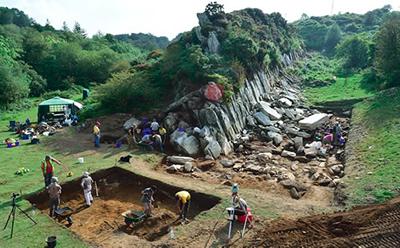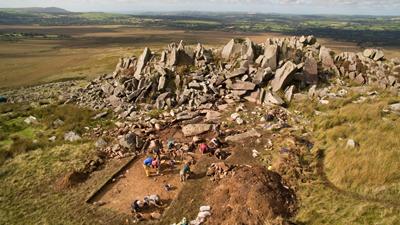Stonehenge ‘bluestone’ quarries confirmed in Wales

Excavation of two quarries in Wales by archaeologists and geologists from a number of organisations, including the University of Southampton, has confirmed they are the sources of Stonehenge’s standing ‘bluestones’.
The discovery, published today in Antiquity, presents detailed evidence of prehistoric quarrying of the bluestones in the Preseli Hills within the Pembrokeshire Coast National Park in west Wales. The research also sheds light on how the stones may have been transported to the Stonehenge site some 170 miles away in Wiltshire.
The megalith quarries are on the north side of the Preseli Hills, which potentially challenges previous theories about how the bluestones may have been transported from Wales to Stonehenge. Previous writers have often suggested that bluestones were taken southwards from the Hills to Milford Haven and then floated on boats or rafts.
The very large standing stones at Stonehenge are of ‘sarsen’, a local sandstone, but the smaller ones, known as ‘bluestones’, come from the Preseli Hills. Geologists have known since the 1920s that the bluestones were brought to Stonehenge from somewhere in the Preseli Hills, but only now has there been collaboration with archaeologists to locate and excavate the actual quarries from which they came.
The special formation of the rock, which forms natural pillars at these outcrops, allowed the prehistoric quarry-workers to detach each standing stone with a minimum of effort.
“They only had to insert wooden wedges into the cracks between the pillars and then let the Welsh rain do the rest by swelling the wood to ease each pillar off the rock face,” said Dr Josh Pollard, Reader in Archaeology at the University of Southampton. “The quarry-workers then lowered the thin pillars onto platforms of earth and stone, a sort of ‘loading bay’ from where the huge stones could be dragged away along trackways leading out of each quarry.”

Radiocarbon-dating of burnt hazelnuts and charcoal from the quarry-workers’ camp fires reveals that there were several occurrences of megalith-quarrying at these outcrops. Stonehenge was built during the Neolithic period, between 4,000 to 5,000 years ago. Both of the quarries in Preseli were exploited in the Neolithic, and Craig Rhos-y-felin was also quarried in the Bronze Age, around 4,000 years ago.
Director of the project, Professor Mike Parker Pearson, UCL Institute of Archaeology, said: “This has been a wonderful opportunity for geologists and archaeologists to work together. The geologists have been able to lead us to the actual outcrops where Stonehenge’s stones were extracted.”
Phil Bennett, Pembrokeshire Coast National Park Authority’s Culture and Heritage Manager, added: “This project is making a wonderful contribution to our knowledge of the National Park’s importance in prehistory.”
The project, led by University College London (UCL), includes experts from Southampton, Manchester and Bournemouth universities, Amgueddfa Cymru – National Museum Wales, and Dyfed Archaeological Trust. Funding for the excavations has come from the National Geographic Society, the Society of Antiquaries of London, the Royal Archaeological Institute, the National Museum of Wales and the Cambrian Archaeological Association with support from the Pembrokeshire Coast National Park.
Further excavations are planned for 2016.